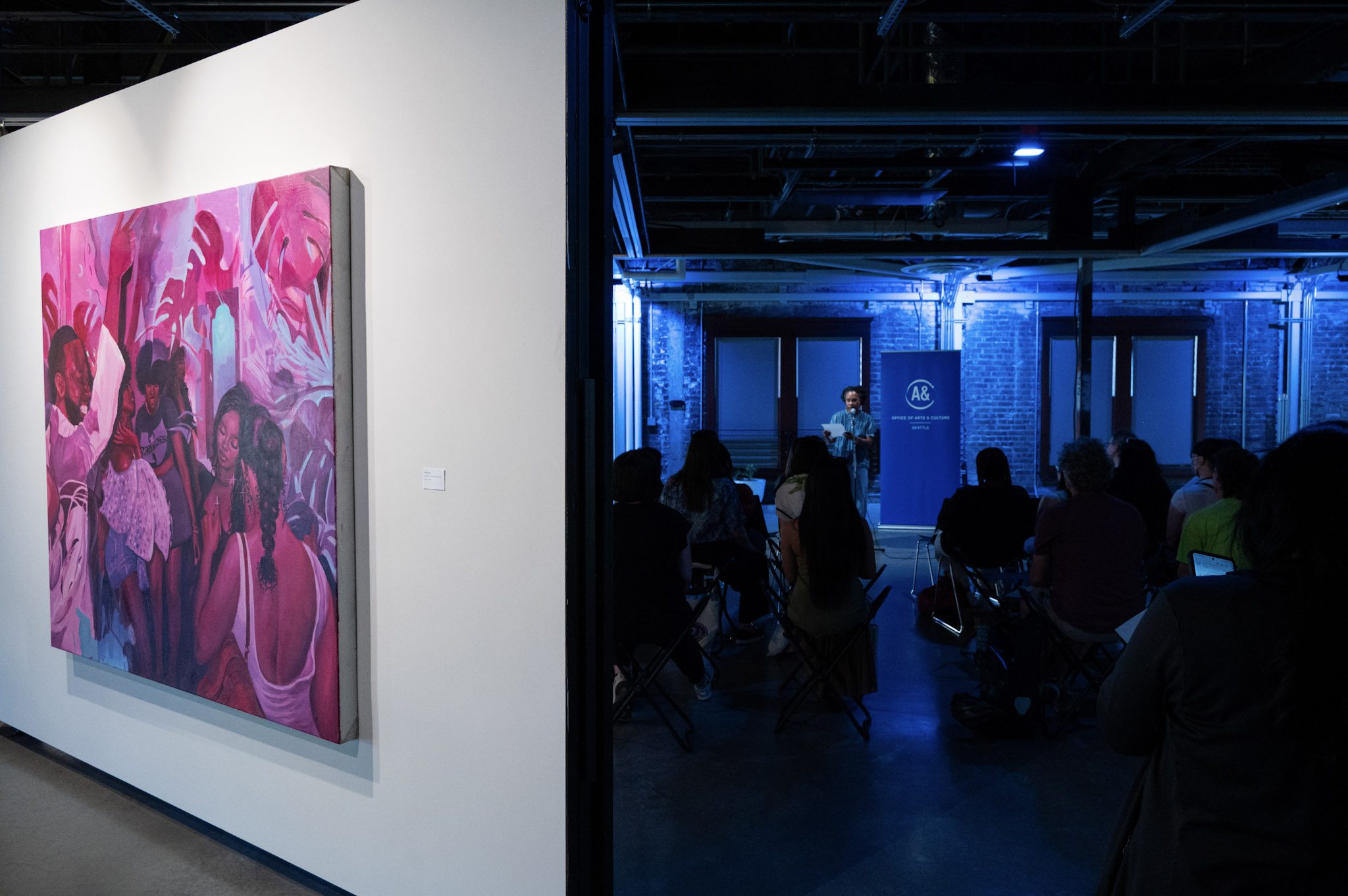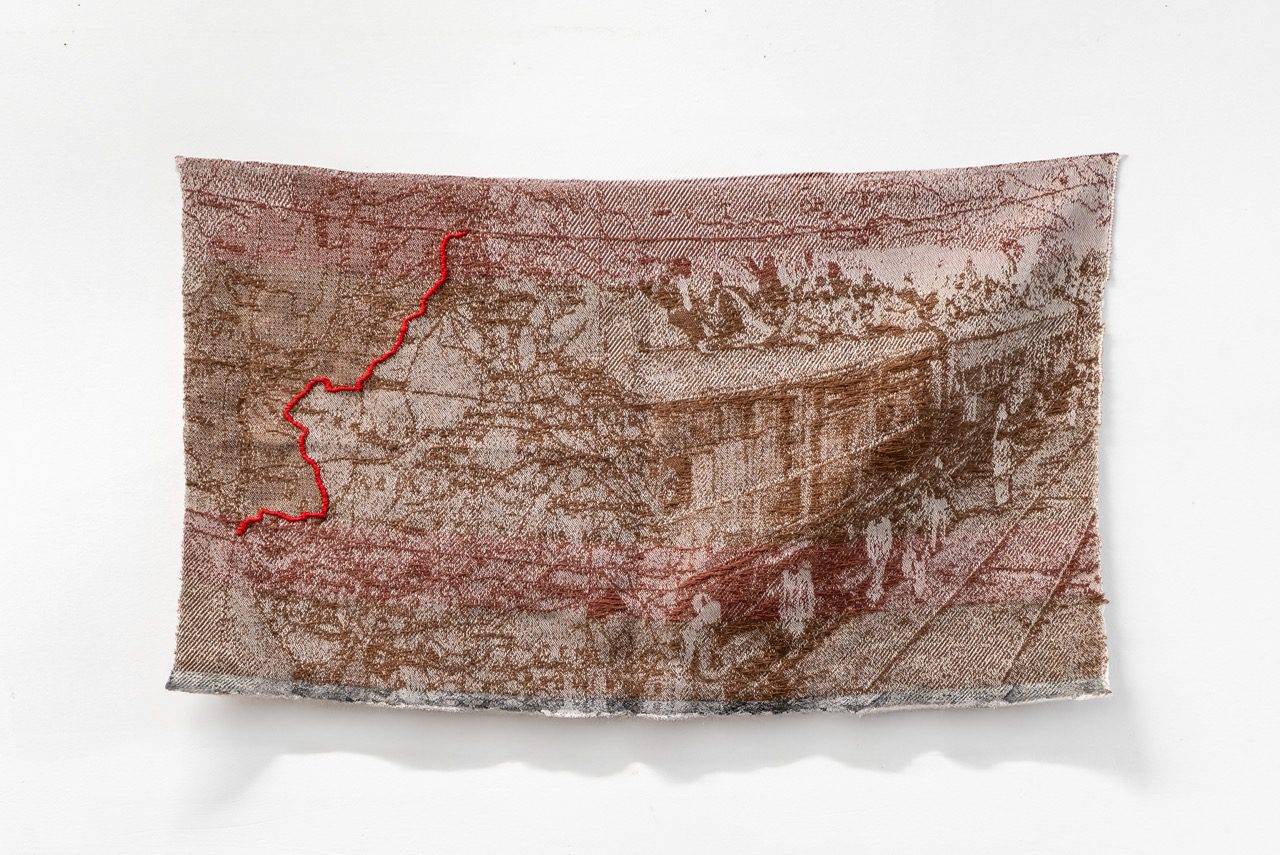“Sometimes you don’t notice things until you’re allowed to look for them,” says teaching artist Mario Lemafa, to a dozen teenagers in The Wing Luke Museum’s YouthCAN program. The Office of Arts & Culture Youth Arts Project Manager Irene Gomez and I are sitting in on a session of the program, and spatial poetics (art that incorporates text) is the topic of the week. YouthCAN typically offers three to four art sessions a year and this fall’s session topic is avant-garde Asian art, taught by multimedia artist Mario Lemafa. Mario is joined by Minh Nguyen, the YouthCAN Manager, a program which encourages teenagers to notice the arts world around them, critique their worlds and contribute to their communities.
 I imagine the topic of spatial poetry doesn’t come up in a typical high school class, which is why it’s so important for programs like this to exist – to expose teenagers to unconventional, contemporary art forms which might not even be covered on the AP level. Mario’s Powerpoint slides jumped between artworks and poetry by international artists such as Yoko Ono and Ken Lum, and local artists like Jason Hirata, showing that both playing with texts and contexts can both be examples of spatial poetics, such as “Ceiling Painting (YES Painting)” (pictured left) by Yoko Ono. Along with that piece, the slides showed photos of food found in strange places, posters of bubble tea, billboards, and more all having to do with the way poetry and visual imagery fills space in beautiful ways were introduced to the high school age students, with confusion and curiosity filling the room. Minh also had Hans-Ulrich Obrist’s book Do It on hand for perusing more examples of spatial poetry.
I imagine the topic of spatial poetry doesn’t come up in a typical high school class, which is why it’s so important for programs like this to exist – to expose teenagers to unconventional, contemporary art forms which might not even be covered on the AP level. Mario’s Powerpoint slides jumped between artworks and poetry by international artists such as Yoko Ono and Ken Lum, and local artists like Jason Hirata, showing that both playing with texts and contexts can both be examples of spatial poetics, such as “Ceiling Painting (YES Painting)” (pictured left) by Yoko Ono. Along with that piece, the slides showed photos of food found in strange places, posters of bubble tea, billboards, and more all having to do with the way poetry and visual imagery fills space in beautiful ways were introduced to the high school age students, with confusion and curiosity filling the room. Minh also had Hans-Ulrich Obrist’s book Do It on hand for perusing more examples of spatial poetry.
After the short presentation and collective critique of the examples, it was time for everyone to take some advice from Obrist, and ‘do it.’ In pairs, we walked around the International District to capture spatial poetry as it exists in the world. Mario, who was very excited both about this project in particular, and the beauty of the neighborhood, participated in the project, running across the streets to show me his favorite doorways and sidewalk tiles that exhibit spatial poetry.
As he took a picture through a window of a faded Mona Lisa poster that was hanging in an apartment lobby, Mario looked at me and said, “This activity allows the students the opportunity to see the beauty in the ordinary.” On our exploration, we’d often run into the students, as our parameters were a 3 block radius to look for our inspirations, who were having a great time exploring the neighborhood in ways they have never experienced before.
 When we joined back up with the group, the teens shared their findings with each other, phones getting passed around, giggles and shrieks exchanged, along with an accusatory, “I KNEW you were going to take a picture of that.” Snapchat, an ephemeral app where content shared with friends disappears after either a few seconds or a day depending on the setting, was a popular way to send their spatial poetics findings with each other instantly, and then have them disappear from cyberspace forever. It was a new kind of shared experience, an exercise in spatial poetry in itself.
When we joined back up with the group, the teens shared their findings with each other, phones getting passed around, giggles and shrieks exchanged, along with an accusatory, “I KNEW you were going to take a picture of that.” Snapchat, an ephemeral app where content shared with friends disappears after either a few seconds or a day depending on the setting, was a popular way to send their spatial poetics findings with each other instantly, and then have them disappear from cyberspace forever. It was a new kind of shared experience, an exercise in spatial poetry in itself.
Inside, the pieces that the students decided to save on their cell phone camera rolls (meaning they would stay longer than a few seconds or a day) were examined and discussed, (“Snapshots vs. Snapchats,” Minh remarked). Imagery included murals, graffiti, stickers, references to local bands/skate teams, and quotes scribbled on walls, such as “who could deny me the right to fly” inside a cartoon birdcage.
 Now it was time for the students to create some spatial poetry of their own. Minh gave wise advice:
Now it was time for the students to create some spatial poetry of their own. Minh gave wise advice:
“I know a lot of you are stressed. If that’s your focus, try to use this exercise to relieve that stress. Or write instructions to relax,” and I wondered how often teenagers get to hear a statement like that, to get instructions to relax these days.
This YouthCAN workshop continues throughout 2014, and a new program about fashion starts up in the spring. For more information: visit the YouthCAN website.
— By Annie Holden
The Wing Luke Museum’s YouthCAN program is one of the Office of Arts & Culture’s 2014 Youth Arts grant recipients. Youth Arts is an annual funding program that makes a difference in the lives of Seattle middle and high school youth by providing arts education beyond the regular school day in neighborhoods throughout the city. To find more out about this program, check out our website.
Image of Yoko Ono from http://16sparrows.typepad.com/16sparrows/2013/01/words-image-yes.html. All other photos by Annie Holden.


